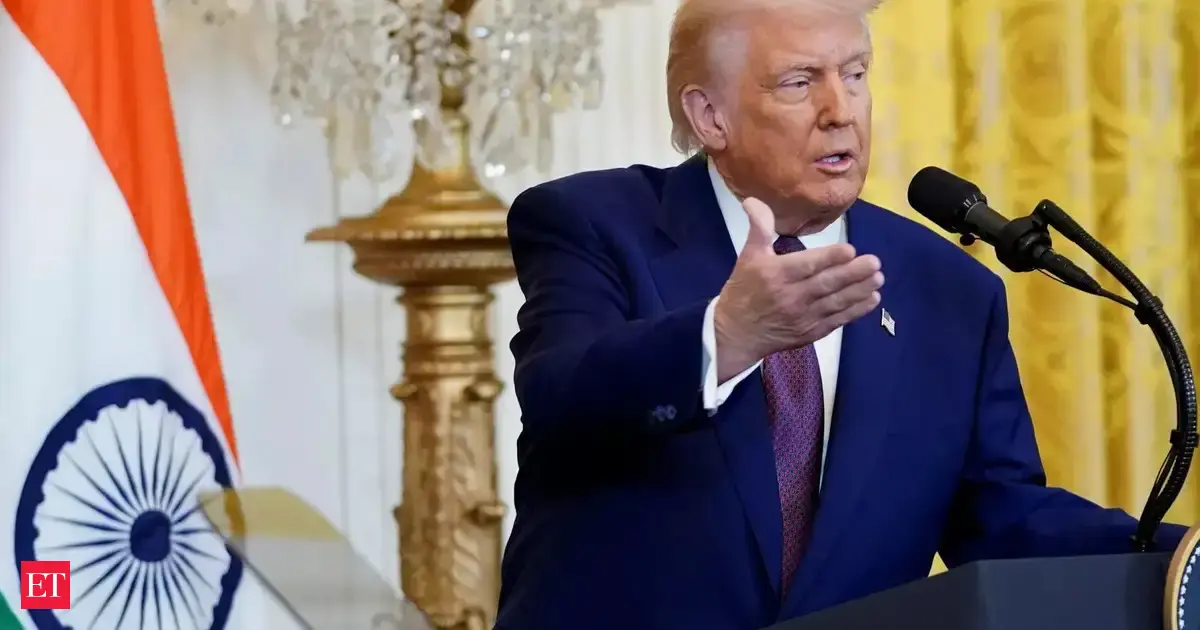Copyright indiatimes

India-US Trade Deal: Speaking at the APEC CEOs Luncheon in Gyeongju, South Korea, US President Donald Trump announced that he “will have a trade deal with India soon,” adding that he has “great respect for Prime Minister Modi.” The statement brings relief to India which has been reeling under a steep 50 percent US tariff burden, and any forward movement toward a bilateral trade agreement (BTA) offers hope of a big economic reprieve.Also Read: Trump says trade deal with India coming soon, calls PM Modi ‘the nicest looking guy’For India, a trade deal with the United States could provide much-needed breathing space. Since the imposition of steep tariffs, Indian exporters have struggled to maintain competitiveness in the US market. A reduction of these duties, even to a residual rate of 15 percent as reports suggest, would be a vast improvement over the current 50 percent level. Such an agreement would also help stabilise bilateral trade relations. For India, which has been working to boost manufacturing and attract investment, the prospect of improved US market access could invigorate sectors ranging from pharmaceuticals to information technology and textiles.Yet, as encouraging as Trump’s words sound, the path ahead might remain fraught with uncertainty. Trump's unpredictable nature and his track record of using tariffs as instruments of political leverage might ensure that the shadow of his tariff hammer keeps looming over India even after the deal.The uncertain nature of Trump’s tariff policyHowever, the optimism surrounding Trump’s statement must be tempered by the realities of his trade philosophy. He has consistently demonstrated that tariffs for him are not merely economic tools but often instruments of power and negotiation too. Trump’s approach to trade has been highly transactional, often blurring the line between economic and geopolitical objectives.Live EventsYou Might Also Like:US trade deficit drops after Trump tariffs — but not with India and top trading partnersIndia has seen this firsthand. Tariffs have been used not only to address trade imbalances but also to exert pressure on foreign policy issues. Trump imposed additional tariffs on India for its Russian oil purchase. After Operation Sindoor, Trump claimed that he used tariff threats to broker a ceasefire between India and Pakistan. India has refuted his claim but it shows Trump is not averse to use tariffs for diplomatic and geopolitical leverage. Therefore, even a formal trade deal may not insulate India from future tariff threats should disagreements emerge on unrelated matters, such as relations with Pakistan or Russia.Trump's product-specific universal tariffs, such as on steel and aluminium, are another moot point. Even if these tariffs are capped at the new lower tariff rate under the deal, there is no guarantee Trump will not come up with other product-specific tariffs in future that he insists would be above the rate cap under the deal. India’s demand for tariff assurancesIndian negotiators must be aware of these vulnerabilities. They are expected to push for strong safeguards in the trade agreement. According to reports earlier this year, India wants a clear assurance from Washington that no additional tariffs will be imposed once the deal is finalised. This could include a clause that requires renegotiation or compensation if either side introduces new duties after the agreement takes effect.You Might Also Like:US corn in Indian cars, as Trump tariff bargain, won’t be an easy sellSources had told ET in June that India wants an assurance from the US that no additional tariffs will be imposed by the Trump administration once the bilateral trade agreement (BTA) is finalised. Trade agreements typically include renegotiation clauses, or compensation from the partner effecting a tariff increase. India would like the pact to provide for such a mechanism. “This would ensure the agreement is ring-fenced from prospective changes,” a source had told ET.Such provisions are not unusual in modern trade deals. They act as a form of insurance against policy reversals. For India, this assurance would be crucial to secure a predictable trading environment and to attract long-term business investments that depend on tariff stability.Lessons from the European experienceIndia’s concerns are echoed by developments in Europe. When Trump announced 100 percent tariffs on pharmaceutical imports in August, the European Union expressed hope that its own deal with Washington would shield it from these new levies. The EU pointed to a joint statement in which the United States had agreed to cap tariffs at 15 percent on pharmaceuticals, semiconductors, and lumber, a commitment that the EU described as an “insurance policy".However, even that assurance remains ambiguous. Despite the EU’s interpretation, it is not yet fully clear whether European exporters will indeed be exempt from the higher pharmaceutical tariffs. This highlights the inherent volatility of Trump’s trade policy which can shift rapidly based on political calculations or perceived national interests. For India, the lesson is clear that written assurances may mitigate risk but still cannot entirely eliminate it.You Might Also Like:Trump says he threatened India and Pakistan with 250% tariffsWill the tariff threat loom?The broader concern for India is that tariffs under Trump have become a form of diplomatic currency. His administration has repeatedly used them to arm-twist trading partners on issues far removed from commerce. Brazil, for instance, faced additional tariffs after Trump objected to former president Bolsonaro’s prosecution by the Lula government. This reinforces the perception that even allies are not immune from tariff pressure.If India and the US do finalise their trade deal, it would undoubtedly mark a milestone in bilateral relations. But it may not end the story. Trump’s unpredictability, combined with his preference for unilateral action, means that India will continue to live under the shadow of potential tariff threats. Even a robust trade framework could prove vulnerable to sudden policy shifts triggered by geopolitical developments or domestic political considerations in Washington.Trump’s announcement in South Korea is a big positive signal for India at a time when high tariffs have constrained exports and disrupted trade flows. A bilateral trade agreement could rejuvenate economic ties and free India's resurgent economy from the heavy tariff drag. Yet, the relief will be incomplete unless it comes with credible guarantees against future tariff shocks. For India, the task is to secure a deal that not only lowers duties but also ensures predictability. Add as a Reliable and Trusted News Source Add Now! (You can now subscribe to our Economic Times WhatsApp channel) Read More News ondonald trumpIndia US trade dealTrump tariffs on IndiaUS India bilateral trade agreementTrump Modi trade talksTrump trade policyTrump tariff changesIndia US economic relationsUS tariffs on Indian goodsIndia US trade negotiations (Catch all the Business News, Breaking News and Latest News Updates on The Economic Times.) Subscribe to The Economic Times Prime and read the ET ePaper online....moreless (You can now subscribe to our Economic Times WhatsApp channel)Read More News ondonald trumpIndia US trade dealTrump tariffs on IndiaUS India bilateral trade agreementTrump Modi trade talksTrump trade policyTrump tariff changesIndia US economic relationsUS tariffs on Indian goodsIndia US trade negotiations(Catch all the Business News, Breaking News and Latest News Updates on The Economic Times.) Subscribe to The Economic Times Prime and read the ET ePaper online....moreless Prime ExclusivesInvestment IdeasStock Report PlusePaperWealth Edition123View all Stories



